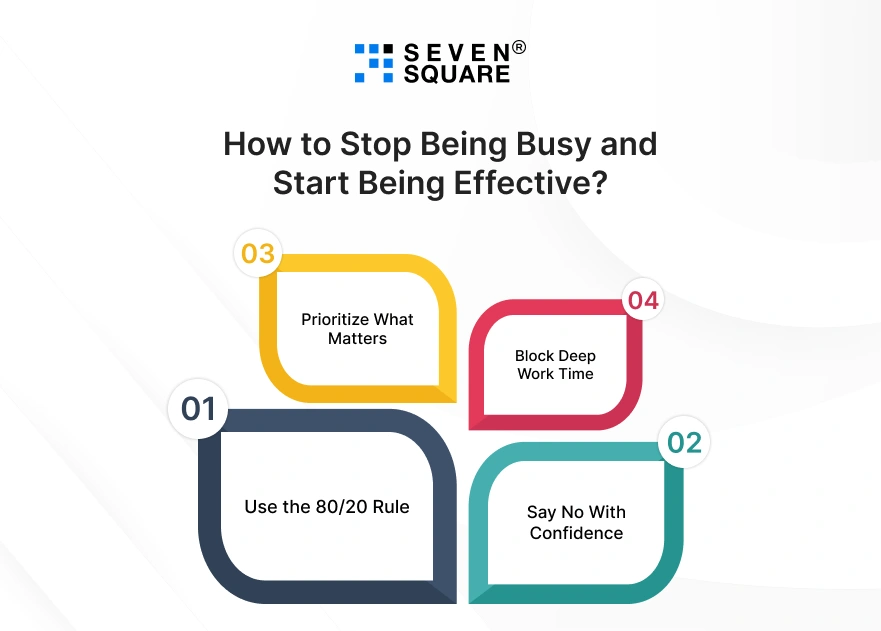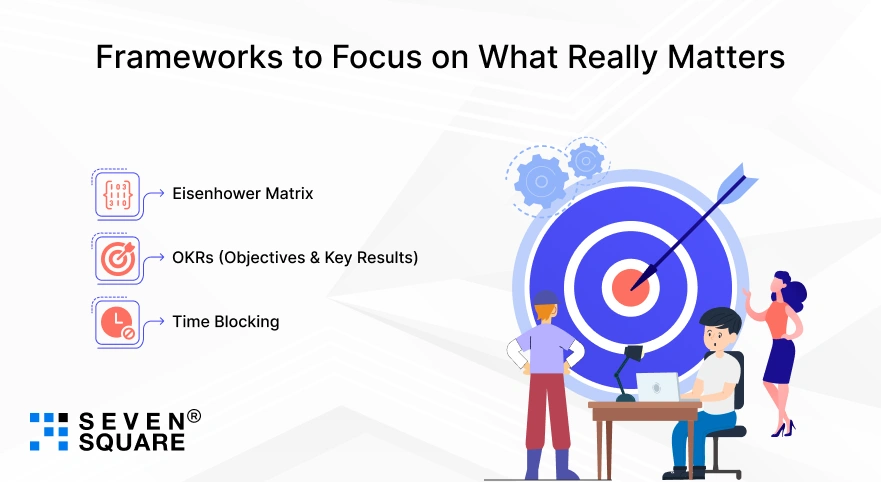Have you ever finished a long day, ticked off many tasks, but still felt like nothing important got done? That’s the difference between busy vs productive.
Founders are stuck in endless emails, managers jump from meeting to meeting, and developers handle sprint after sprint.
Everyone is working hard, but the results are not growing. That’s the gap between busy vs effective.
These are clear signs you are busy but not productive, spending time on fake work vs high-impact work. For example, creating extra reports or replying to every message is busy work.
But improving product quality, building better features, or keeping clients happy is productive work. In short, movement is not the same as progress.
Examples of busy work vs productive work show us this difference clearly. Real growth comes only when we focus on results, not just tasks.
The truth is simple: Being busy doesn’t mean effective; it often means distracted.
The Hard Truth: Busy Doesn’t Mean Effective
Here’s the truth most teams don’t want to admit: There’s a big difference between busy vs productive, and an even bigger gap when it comes to busy vs effective.
One of our clients once worked nonstop for weeks, solving every bug, every small request, every “urgent” task.
Their team was drained, but the main release, the only thing customers cared about, was still late.
That’s when they realized the signs you are busy but not productive: chasing low-value tasks, celebrating activity instead of outcomes, & losing sight of the bigger picture.
The lesson? Examples of busy work vs productive work are everywhere.
Busy work feels good because it keeps you moving. Productive work feels harder, but it creates meaningful impact.
What Are the Signs That You’re Stuck in “Busy Work” Mode?
We’ve seen both startups and enterprises fall into this trap. If any of these sound familiar, you’re likely stuck in fake work vs high-impact work mode:
- You’re always in meetings, but little real progress shows up at the end of the week.
- You’re constantly checking off tasks, but none of them actually move the business forward.
- You’re saying yes to everything, but still delivering nothing truly impactful.
These are classic signs that you are busy but not productive.
What “Results-Driven Work” Really Looks Like?
Here’s the difference: productivity vs busyness examples are not about working harder; they’re about working smarter.
Busy work looks like:
- Sending status reports no one reads.
- Attending meetings without decisions.
- Chasing every request, urgent or not.
But effective, results-driven work looks like:
- Shipping a product update that reduces checkout time by 40%.
- Running overnight QA cycles that guarantee zero downtime for a client launch.
- Saying “no” to low-value requests so you can deliver the one feature customers are waiting for.
These are examples of busy work vs productive work we’ve seen first-hand at Seven Square.
And here’s the pattern: When teams shift from activity to outcomes, launches become smoother, clients get happier, and businesses grow faster.
How to Stop Being Busy and Start Being Effective?

At Seven Square, we’ve seen too many founders and developers fall into the trap of endless task lists.
The truth is: Real progress comes when you stop doing busy work and focus on results. Here’s our playbook:
1. Use the 80/20 Rule
- Not all tasks are equal.
- Learn how to use the 80/20 rule to focus on results & spend 80% of your time on the 20% of tasks that drive outcomes.
2. Say No With Confidence
- The hardest part of effectiveness is how to say no to low-value tasks at work.
- Every “yes” to fake work means a “no” to high-impact work.
3. Prioritize What Matters
- We help teams master steps to prioritize high-impact tasks at work, from choosing client-first initiatives to focusing only on outcome-driven goals.
4. Block Deep Work Time
- Distractions kill impact.
- We show teams how to focus with constant interruptions by creating deep work blocks, no meetings, no noise, just results.
Our Real Story: From Busy to Breakthrough
- One of our fintech clients thought they were productive, sprinting daily with endless to-dos. But results lagged.
- When we showed them how to stop doing busy work and focus on results, everything changed.
- By shifting to just 3 high-impact priorities, they not only met deadlines but boosted system performance by 40%.
- That’s the secret of how to be productive, not busy: fewer tasks, sharper focus, bigger results.
Frameworks to Focus on What Really Matters

We use proven frameworks that simplify how to set priorities when everything seems urgent:
- Eisenhower Matrix: Sort urgent vs. important tasks.
- OKRs (Objectives & Key Results): Tie daily work to business goals.
- Time Blocking: Schedule focus, not just tasks.
These prioritization techniques help founders and teams cut noise and focus on what moves the needle.
Why Do We Choose Effectiveness Over Busyness?
We’ve learned that fake work vs high-impact work makes the difference between burnout and breakthroughs.
We measure success not in hours logged, but in results delivered. Our culture is built on:
- Trust: Clients know we focus on what matters.
- Transparency: We cut busy work and show progress clearly.
- Client-First Mindset: Every task ties back to client outcomes.
This is how we turn busyness into effectiveness and why our clients stay with us.
Want a Focused Development Team? Contact Us Today!
Your Daily Routine to Get Results (Not Just Stay Busy)
Here’s a simple daily routine to stop being busy and get results, the same rhythm we use at Seven Square:
- Morning Priority Setting: Pick your top 3 impact tasks.
- Deep Work Sessions: Two distraction-free blocks of 90 minutes.
- No-Meeting Blocks: Protect your creative energy.
- Evening Reflection: Check progress and reset for tomorrow.
Small changes in routine can create massive results.
Busy is a Trap & Results are the Goal
The message is clear: busy vs productive is the real game.
Being busy doesn’t mean effective; it often means distracted.
The only way forward is to focus on what matters and measure success by results, not tasks.
FAQs
- Busy means lots of activity with little impact. Productive means achieving meaningful outcomes with focus.
- That’s the core of busy vs productive.
- Apply the 80/20 rule, say no to low-value work, block deep work time, and focus only on high-impact priorities.
- That’s how to be productive, not busy.
- Endless meetings, long task lists, saying yes to everything, but no real progress.
- These are classic signs that you are busy but not productive.
- Use prioritization techniques like the Eisenhower Matrix and OKRs to align work with outcomes.
- That’s how to stop doing busy work and focus on results.